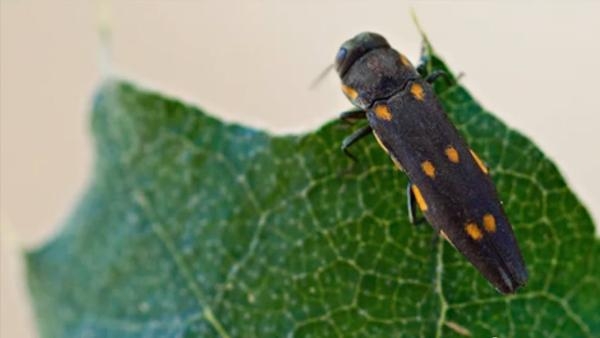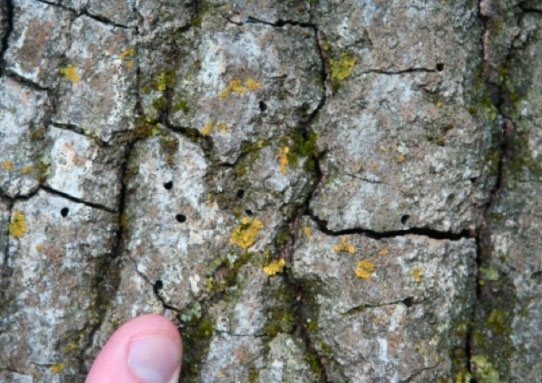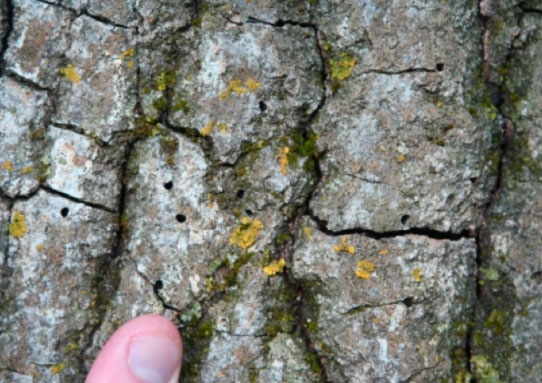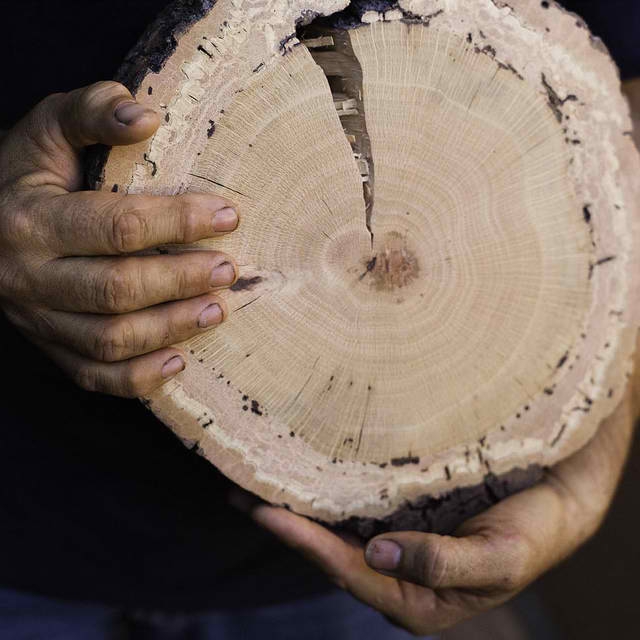Posts Tagged: goldspotted oak borer
Movie star helps raise awareness about threats to California oaks
When actress René Russo appeared in a video (posted below) about “New Oak Threats,” she wasn’t acting. The veteran of big-budget thrillers like Lethal Weapon 3 and 4 and the Thomas Crown Affair expressed her personal convictions when she called for Californians to become educated and observant guardians of California oaks.
“I love our beautiful oak trees,” Russo said. “But there’s a new pest in town, and we could potentially lose every tree that we have. It would change the face of Southern California. It’s terrifying.”
The actress says the death of 80,000 oak trees in San Diego County since 2008 from goldspotted oak borer is one example of the devastation wreaked by one invasive pest.
“We need your help to save the trees,” Russo said.
The video presents the tell-tale signs of two serious threats to oaks - goldspotted oak borers (GSOB), which leave “D” shaped exit holes in the bark, and polyphagous shot hole borers (PSHB), which exit bark from small, black rimmed holes surrounded by wood discoloration.
Goldspotted oak borer, a native of southeastern Arizona, feed beneath the bark of certain oak trees. After several years, the damage to nutrient- and water-conducting tissue kills the tree.
Polyphagous shot hole borer carries a fungus from tree to tree when it burrows in bark to lay eggs. The fungus grows and spreads throughout susceptible trees. Some trees suffer branch die-back, while others are killed outright. The polyphagous shot hole borer is not only a threat to oaks but it can also affect more than 200 other tree species, including native California sycamore, avocado, and many popular street tree species.
“It’s really a whole landscape changer,” said certified arborist Rosi Dagit of the Resource Conservation District of the Santa Monica Mountains. “All of our street trees, our urban landscape trees and all of our wildland trees are at risk. What we really need are eyes on the ground.”
In the second half of the video, Sabrina Drill, UC Cooperative Extension advisor in Los Angeles County, explains what Southern Californians can do to protect trees.
- Visit the website Southern California Oak Pests (http://ucanr.edu/socaloakpests) to learn about the pests.
- Educate your friends, neighbors and community leaders about the pests.
- Don’t move firewood in and out of your local area. If you buy firewood, ask where it came from. On camping trips, burn wood you collect or purchase and don’t take any home. For more on firewood see the website Dontmovefirewood.org.
- Learn what to look for and report your observations on the Southern California oak pests website.
- Be an advocate for your trees.
“Hopefully, we can get this done,” Russo said. “We’ve lived with these beautiful oak trees for thousands of years. It would be devastating to lose them.”
The video, a joint effort of UC Cooperative Extension and the Resource Conservation District of the Santa Monica Mountains, was produced, directed and edited by Toby Keeler of Fine Cut Inc.
Watch the 10-minute video here:
More trees infested with goldspotted oak borer
Two more trees in Idyllwild are infested with goldspotted oak borer, reported the Riverside Press-Enterprise yesterday. The announcement came at a community meeting over the weekend, in which Tom Scott, UC Cooperative Extension specialist in the Department of Natural Resources at UC Riverside, and Kevin Turner, UC Cooperative Extension goldspotted oak borer program coordinator, joined fire and forestry officials to brief local residents about the new pest threat in the area.
Residents learned how to examine oak firewood this winter and how watch their black oaks and coast live oaks this spring for signs that they may harbor the insect. Firewood or trees suspected of being infested should be reported to (951) 659-3850, the story said. More information is available at the UC Cooperative Extension GSOB website.
Officials enlist mountain residents to battle goldspotted oak borer
Cal Fire, UC Cooperative Extension and other officials will be meeting with residents of Idyllwild tomorrow to enlist their help in stopping the goldspotted oak borers' tree destruction in the picturesque mountain community, reported the Riverside Press-Enterprise.
GSOB appears to have spread to Idyllwild by hitchhiking on firewood from San Diego, where it has killed some 80,000 oak trees. It has been found in only one tree in Idyllwild so far.
Tom Scott, UC Cooperative Extension specialist in the Department of Environmental Sciences at UC Riverside, and Kevin Turner, UCCE goldspotted oak borer program coordinator, will be among the speakers.
Meanwhile, ABC Eyewitness News in Los Angeles interviewed UC Riverside entomologist Vanessa Lopez about an effort to bring in GSOB predators to California from Arizona.
"What we're hoping to do is go to Arizona and find those insects that are specialized to only feed on goldspotted oak borer and they're efficient at controlling the population," Lopez said.

Small size but big destruction, the goldspotted oak borer. (Photo: UC Riverside)
Don’t move firewood and pests
“Buy firewood from a local source close to your home to prevent the spread of insects and diseases, such as the goldspotted oak borer, sudden oak death and emerald ash borer,” said Tom Scott, a UC Cooperative Extension specialist based at UC Riverside who studies these invasive pests.
“Firewood is one of the least-regulated natural resource industries in California,” said Scott, “but this is a situation where the university can play a critical role in changing behavior through research and education rather than regulation.”
Scott and his UC Cooperative Extension colleagues are working with the U.S. Forest Service, the California Firewood Task Force and other agencies to educate and discourage woodcutters, arborists, firewood dealers and consumers from transporting infested wood.
“Many people don’t realize that firewood can harbor harmful insects and plant pathogens. Moving around infested wood can introduce those pests and pathogens to new areas where they might take hold and could have devastating impacts to trees, our natural resources and local communities,” said Don Owen, California Firewood Task Force chair and CAL FIRE forest pest specialist based in Redding.
“Even wood that looks safe can harbor destructive pests,” cautioned Janice Alexander, UC Cooperative Extension sudden oak death outreach coordinator in Marin County.
For example, female goldspotted oak borers lay eggs in cracks and crevices of oak bark, and the larvae burrow into the cambium of the tree to feed so they may not be visible.
The goldspotted oak borer has killed more than 80,000 oak trees in San Diego County in the last decade and Scott hopes it can be contained in that region. The half-inch-long beetle is native to Arizona but not to California and likely traveled in a load of infested firewood, according to Scott.
In his research, Scott has found outbreaks of goldspotted oak borer 20 miles from the infested area, which leads him to believe movement in firewood is the most likely reason for the beetle leap-frogging miles of healthy oak woodlands to end up in places like La Jolla. In communities where people harvest local trees for firewood, oaks have remained relatively beetle-free, Scott said.
In addition to concealing goldspotted oak borer, firewood may harbor other destructive invasive species such as emerald ash borer or the pathogen that causes sudden oak death. Sudden oak death has killed more than a million oak and tanoak trees in 14 coastal California counties, from Monterey to Humboldt. The highly destructive emerald ash borer has been identified in Michigan, Indiana, Ohio and Illinois, but not California.
“Our best defense against the GSOB outbreak is the enlightened self-interest of Californians purchasing firewood,” Scott added. “If you want to protect the oaks around your house, neighborhood, and nearby woodlands, make sure that you’re not buying wood that could contain these beetles.”
In a broader sense, buy firewood from reputable dealers, from local sources whenever possible – and try to make sure that the wood you buy has been properly seasoned and doesn’t contain pests.
Tips for buying oak firewood
- Don’t buy green firewood from unknown sources, it has the highest chance of containing pests and pathogens.
- Ask where the firewood originated. If it isn’t local, ask what precautions the seller has taken to ensure that the firewood is free of harmful insects and disease or consider buying from another local source.
- Wood should preferably be bark-free, or have been dried and cured for one year prior to movement.
- If you see D-shaped exit holes, be reluctant to buy unless you know the wood has dried for at least a year or longer.
For more information about the pests and diseases that threaten California’s oaks, visit these websites:

Sudden oak death disease has killed over a million trees in California.
UC researchers discuss oak health in LA
The goldspotted oak borer continues to threaten oak trees, Tom Scott, area natural resource specialist located at UC Riverside, told participants at conference on sustaining native oak woodlands in Los Angeles, the Monrovia Patch reported.
Scott said there is still a quarantine on moving firewood out of San Diego County to prevent the spread of the damaging insect.
Reporter Sandy Gillis wrote that Larry Costello, UC Cooperative Extension environmental horticulture advisor emeritus, described the power of oaks to access water deep in the soil.
UC adds 4,584 acres of forest to its research lands
The Los Angeles Times and San Francisco Chronicle reported on UC's acquisition of 4,584 acres of Northern California mixed-conifer forest as part of a PG&E bankruptcy settlement.
Debra Levi Holtz, who wrote the article for the Chronicle, quoted Keith Gilless, dean of the UC Berkeley College of Natural Resources, which houses the UC Center for Forestry, as saying, "For us, this is a dream come true to have a network of research sites on a north-south transection through the Sierra Nevada and Cascade ranges that will dramatically improve our capacity to do work on forest ecosystems that is responsive to the questions we all have about the impacts of climate change on those regions."



